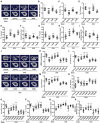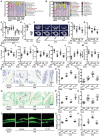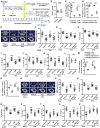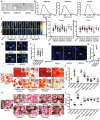Extracellular Vesicles from Child Gut Microbiota Enter into Bone to Preserve Bone Mass and Strength
- PMID: 33977075
- PMCID: PMC8097336
- DOI: 10.1002/advs.202004831
Extracellular Vesicles from Child Gut Microbiota Enter into Bone to Preserve Bone Mass and Strength
Abstract
Recently, the gut microbiota (GM) has been shown to be a regulator of bone homeostasis and the mechanisms by which GM modulates bone mass are still being investigated. Here, it is found that colonization with GM from children (CGM) but not from the elderly (EGM) prevents decreases in bone mass and bone strength in conventionally raised, ovariectomy (OVX)-induced osteoporotic mice. 16S rRNA gene sequencing reveals that CGM reverses the OVX-induced reduction of Akkermansia muciniphila (Akk). Direct replenishment of Akk is sufficient to correct the OVX-induced imbalanced bone metabolism and protect against osteoporosis. Mechanistic studies show that the secretion of extracellular vesicles (EVs) is required for the CGM- and Akk-induced bone protective effects and these nanovesicles can enter and accumulate into bone tissues to attenuate the OVX-induced osteoporotic phenotypes by augmenting osteogenic activity and inhibiting osteoclast formation. The study identifies that gut bacterium Akk mediates the CGM-induced anti-osteoporotic effects and presents a novel mechanism underlying the exchange of signals between GM and host bone.
Keywords: Akkermansia muciniphila; bone homeostasis; extracellular vesicles; gut microbiota.
© 2021 The Authors. Advanced Science published by Wiley‐VCH GmbH.
Conflict of interest statement
The authors declare no conflict of interest.
Figures






Similar articles
-
Akkermansia muciniphila-derived extracellular vesicles mitigate smoking-induced prostate inflammation and fibrosis.Int Immunopharmacol. 2025 Mar 6;149:114195. doi: 10.1016/j.intimp.2025.114195. Epub 2025 Feb 3. Int Immunopharmacol. 2025. PMID: 39904036
-
Human umbilical cord mesenchymal stromal cells-derived extracellular vesicles exert potent bone protective effects by CLEC11A-mediated regulation of bone metabolism.Theranostics. 2020 Jan 16;10(5):2293-2308. doi: 10.7150/thno.39238. eCollection 2020. Theranostics. 2020. PMID: 32089743 Free PMC article.
-
An emerging role of Prevotella histicola on estrogen deficiency-induced bone loss through the gut microbiota-bone axis in postmenopausal women and in ovariectomized mice.Am J Clin Nutr. 2021 Oct 4;114(4):1304-1313. doi: 10.1093/ajcn/nqab194. Am J Clin Nutr. 2021. PMID: 34113963
-
Gut microbiota and bone metabolism.FASEB J. 2021 Jul;35(7):e21740. doi: 10.1096/fj.202100451R. FASEB J. 2021. PMID: 34143911 Review.
-
The Gut Microbiome and Bone Strength.Curr Osteoporos Rep. 2020 Dec;18(6):677-683. doi: 10.1007/s11914-020-00627-x. Epub 2020 Oct 8. Curr Osteoporos Rep. 2020. PMID: 33030683 Free PMC article. Review.
Cited by
-
Organoid extracellular vesicle-based therapeutic strategies for bone therapy.Biomater Transl. 2023 Dec 28;4(4):199-212. doi: 10.12336/biomatertransl.2023.04.002. eCollection 2023. Biomater Transl. 2023. PMID: 38282702 Free PMC article. Review.
-
Extracellular Vesicles in Aging: An Emerging Hallmark?Cells. 2023 Feb 6;12(4):527. doi: 10.3390/cells12040527. Cells. 2023. PMID: 36831194 Free PMC article. Review.
-
Rumen-mammary gland axis and bacterial extracellular vesicles: Exploring a new perspective on heat stress in dairy cows.Anim Nutr. 2024 Sep 16;19:70-75. doi: 10.1016/j.aninu.2024.08.003. eCollection 2024 Dec. Anim Nutr. 2024. PMID: 39628643 Free PMC article. Review.
-
Gut-bone axis perturbation: Mechanisms and interventions via gut microbiota as a primary driver of osteoporosis.J Orthop Translat. 2025 Jan 21;50:373-387. doi: 10.1016/j.jot.2024.11.003. eCollection 2025 Jan. J Orthop Translat. 2025. PMID: 40171106 Free PMC article. Review.
-
The role and applications of extracellular vesicles in osteoporosis.Bone Res. 2024 Jan 23;12(1):4. doi: 10.1038/s41413-023-00313-5. Bone Res. 2024. PMID: 38263267 Free PMC article. Review.
References
-
- Schwarzer M., Makki K., Storelli G., Machuca‐Gayet I., Srutkova D., Hermanova P., Martino M. E., Balmand S., Hudcovic T., Heddi A., Rieusset J., Kozakova H., Vidal H., Leulier F., Science 2016, 351, 854. - PubMed
Publication types
MeSH terms
LinkOut - more resources
Full Text Sources
Other Literature Sources
Medical
Molecular Biology Databases
